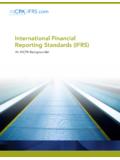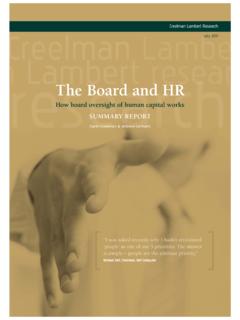Transcription of Science, Technology - OECD
1 Policy BriefOrganisation for Economic Co-operation and Development OECD 2000 September 2000 SummaryScientific advances and technological change are important drivers ofrecent economic performance. The ability to create, distribute andexploit knowledge has become a major source of competitive advan-tage, wealth creation and improvements in the quality of life. Some ofthe main features of this transformation are the growing impact ofinformation and communications technologies (ICT) on the econ-omy and on society; the rapid application of recent scientific advancesin new products and processes; a high rate of innovation across OECD countries; a shift to more knowledge-intensive industries and serv-ices; and rising skill changes imply that science, Technology and innovation are nowkey to improving economic performance and social well-being.
2 How-ever, if governments want to obtain the benefits from this transforma-tion they will have to put the right policies in place. Limits on publicspending, increased competition and globalisation, changes in thedrivers of the innovation process, and a better understanding of therole played by science and Technology in economic performance andsocietal change, have led governments to sharpen their policy , government must become a facilitator, enabling businessand consumers to adapt to the demands and opportunities of the neweconomy. But there are other areas, such as investment in fundamen-tal research and ensuring stakeholders involvement in policy designand implementation, where an active role of government is Policy Brief explores the role of science, Technology and innova-tion in the new economy and discusses the role of government in fos-tering scientific and technological progress for economic growth andgreater social is the role ofscience, Technology andinnovation in the neweconomy?
3 Is there other evidencethat innovation isstronger?What about innovation inthe services sector?What is the role ofscience in innovation?What role do innovationnetworks play?Has the environment forinnovation changed?How can governmentsimprove the environmentfor innovation?What is the role ofgovernment in fundingscience?Is government supportto private R&D effective?Is government policyadjusting to innovation inthe new economy?What next?For further readingWhere to contact usScience, Technology and Innovation in the New Economy2 Policy BriefScience, Technology and Innovation in the New EconomyWhat is the role of science, Technology and innovation in the new economy?
4 Recent OECD analysis shows thatscience, Technology and innovationplay a significant role in economicperformance. In recent years, multi-factor productivity (MFP) hasincreased in several OECD countries( Australia, Denmark, Finland,Ireland, Norway, the United States),reflecting greater efficiency in theuse of labour and capital. More rapidMFP growth is generally due toimproved managerial practices,organisational change and, mostimportant, to smarter and moreinnovative ways of producing goodsand services. The increase in MFP isnot the only sign of more rapid tech-nological progress. The quality ofcapital and labour has alsoincreased, due to strong investmentin information and communicationstechnology (ICT) capital and to therising skills of the average worker inOECD economies.
5 ICT, in particular,is a key factor, and has had strongimpacts on productivity in severalcountries, particularly when accom-panied by organisational change andbetter worker skills. It has alsohelped to improve performance inpreviously stagnant services sectors,facilitated communication, reducedthe costs of transaction and enabledmore extensive networking and co-operation among growing role of innovation andtechnological change can be linkedto changes in the innovation proc-ess. Innovation has become moremarket-driven, and innovation sur-veys for 12 European countries sug-gest that over 30% of manufacturingturnover is based on new orimproved products.
6 Scientific outputcontinues to rise across the OECD area and patent data show a surge ofinnovation in all OECD countriesand across many Technology fields,in particular in ICT and biotechnol-ogy. More of the financing of innova-tion is now directed towards newfirms and risky projects. Innovationalso relies much more on network-ing and co-operation, includingbetween science and industry. Arecent analysis of US patent citationsfound that more than 70% of bio- Technology citations were to papersoriginating solely at public scienceinstitutions. Innovation is more glo-bal, arises from many sources and isspread more widely across sectors,including services, thus broadeningthe basis for economic growth.
7 Inaddition, a growing share of manu-facturing exports consists of high-and medium-high-technologygoods, particularly in Ireland, Japanand the United there other evidence that innovation is stronger?There are other indicators that pointto the growing importance of scienceand Technology in recent growthperformance. investment in ICT,which is a crucial factor in the neweconomy, has increased considerablyin recent years. In the second half ofthe 1990s, the diffusion of ICT accel-erated with the emergence of the35302520151050%%01020253035155 Innovation in biotechnology and ICTB iotechnology patents granted by the USPTO,annual growth rate, 1992-99 ICT patents granted by the USPTO,annual growth rate, 1992-99 Source.
8 OECD calculations based on data from the US Patent and Trademark KingdomIrelandFranceJapanUnited StatesFinlandOECDEUN etherlandsSpainAustriaSwitzerlandGermany ItalyFinlandNew ZealandKoreaSwedenCanadaBelgiumUnited StatesAustriaMexicoOECDU nited KingdomDenmarkEUAustraliaIrelandNetherla ndsGermanyItalyNorwayJapanSwitzerlandFra nceSpain35302520151050%%01020253035155 Innovation in biotechnology and ICTB iotechnology patents granted by the USPTO,annual growth rate, 1992-99 ICT patents granted by the USPTO,annual growth rate, 1992-99 Source:OECD calculations based on data from the US Patent and Trademark KingdomIrelandFranceJapanUnited StatesFinlandOECDEUN etherlandsSpainAustriaSwitzerlandGermany ItalyFinlandNew ZealandKoreaSwedenCanadaBelgiumUnited StatesAustriaMexicoOECDU nited KingdomDenmarkEUAustraliaIrelandNetherla ndsGermanyItalyNorwayJapanSwitzerlandFra nceSpain35302520151050%%01020253035155 Innovation in biotechnology and ICTB iotechnology patents granted by the USPTO,annual growth rate, 1992-99 ICT patents granted by the USPTO,annual growth rate, 1992-99 Source.
9 OECD calculations based on data from the US Patent and Trademark KingdomIrelandFranceJapanUnited StatesFinlandOECDEUN etherlandsSpainAustriaSwitzerlandGermany ItalyFinlandNew ZealandKoreaSwedenCanadaBelgiumUnited StatesAustriaMexicoOECDU nited KingdomDenmarkEUAustraliaIrelandNetherla ndsGermanyItalyNorwayJapanSwitzerlandFra nceSpain3 Policy BriefScience, Technology and Innovation in the New EconomyInternet, although considerable dif-ferences among countries in intangible assets education, research and develop-ment (R&D), software is alsostrong. Education is important, asthe new technologies require skilledworkers. Over the past generation,the proportion of adults with at leasta secondary education level rosefrom 44% to 72% of the total OECD population and the share of adultswith at least a tertiary educationlevel doubled, from 22% to 41%.
10 Theshare of knowledge-based sectors invalue added and employment alsocontinues to rise. In 1997, theyaccounted for around 50% of totalvalue added in Australia, the Euro-pean Union and the United States,considerably above their sharein funding of innovation hasbecome more market-driven overthe past decade. With the end of thecold war, defence R&D has , government R&D fell rel-ative to GDP during much of the firsthalf of the 1990s, as depressed cycli-cal conditions and large budget defi-cits limited public spending, and theeconomic slowdown of the early1990s led to a sharp drop in totalOECD R&D intensity. In recentyears, investment in R&D has budget deficits haveimproved, and countries such asFinland and Japan have strength-ened their public funding.














